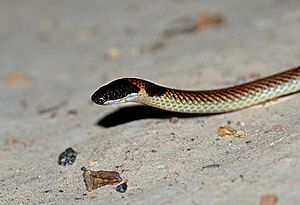Red-naped snake facts for kids
Quick facts for kids Red-naped snake |
|
|---|---|
 |
|
| Scientific classification | |
| Genus: |
Furina
|
| Species: |
diadema
|
| Synonyms | |
|
|
The red-naped snake (Furina diadema) is a small, venomous reptile. It belongs to the Elapidae family of snakes. These snakes live in four states in Australia. They are listed as 'threatened' in Victoria, which means their numbers are getting low.
Red-naped snakes are active at night. They hunt and eat small skinks. Young eastern brown snakes look similar to red-naped snakes.
Contents
What Does It Look Like?
The red-naped snake has small black eyes. Its head and neck are shiny black. The head looks a bit flat. There is a white stripe on its upper lip. On the back of its neck, there is a clear patch of orange or red. This patch can be shaped like a diamond, crescent, or oval.
The snake's belly is usually cream or white. The rest of its body is a red-brown color. The edges of the scales on its back are black or dark brown. This makes the scales look like a net pattern.
Red-naped snakes have a thin body. They are considered small snakes. They can grow up to 45 centimeters (about 18 inches) long. Males are usually smaller than females.
Is Its Venom Dangerous?
Even though red-naped snakes are venomous, their bite is not harmful to humans. If they feel threatened, they will strike out. They often do this with their mouth closed. They can bite if they are bothered enough, but their venom is not strong enough to hurt people.
Where Does It Live?
The red-naped snake lives on land. It can be found in many parts of eastern Australia. It likes dry woodlands and forests. It also lives in coastal forests, heaths, and shrublands. It usually stays away from wet places like rainforests.
These snakes hide in many spots. They shelter under rocks and fallen wood. They also live in ant or termite nests. You might find them under wood piles, leaves, or old metal sheets. They also use cracks in the ground and abandoned animal burrows.
Where Can You Find It?
The red-naped snake lives in four Australian states. These are Victoria, New South Wales (NSW), Queensland, and South Australia. They live in both dry and humid areas. You can find them from Port Augusta in South Australia all the way to Cairns in northern Queensland.
They have been seen in places like Coongie Lakes in South Australia. They are also in Woomargama National Park in NSW. The Museum of Victoria notes they are in the far north-west of Victoria. They also live in 18 National Parks in Queensland.
What Does It Eat?
Red-naped snakes mostly eat small skinks.
Life Cycle and Reproduction
Red-naped snakes lay eggs. This means they are oviparous. The number of eggs they lay can be different. Some records show 2 to 5 eggs, while others say 1 to 10. On average, they lay about 3 eggs.
In warmer areas, red-naped snakes can lay eggs more than once a year. The baby snakes hatch from their eggs in January. If it's a cooler area, they might hatch in February. When they are born, they are usually about 12 to 15 centimeters long. They become adult snakes within one year.
How Does It Behave?
Red-naped snakes are nocturnal. This means they are active at night. Sometimes, they even share their hiding spots with other red-naped snakes.
They use both venom and squeezing (constriction) to catch their prey. They eat more during the warmer parts of the year. They hunt for food in tight spaces like burrows and cracks in the ground.
Similar Snakes
The red-naped snake looks a lot like a young eastern brown snake. However, the eastern brown snake has a lighter band between its dark head and neck.
You can also tell them apart by their behavior. Eastern brown snakes are active during the day. Red-naped snakes are nocturnal, so you won't often see them unless their hiding place is disturbed.
How Is It Protected?
The red-naped snake is listed as 'Threatened' in Victoria. This is under a law called the Flora and Fauna Guarantee Act 1988. This law helps protect plants and animals that are at risk.
Where Did It Come From?
Scientists believe that many years ago, some venomous snakes from Asia moved to Australia. Over time, these snakes evolved into different types, including the Furina species like the red-naped snake.
Images for kids
See also
 In Spanish: Furina diadema para niños
In Spanish: Furina diadema para niños


